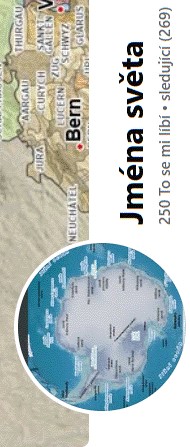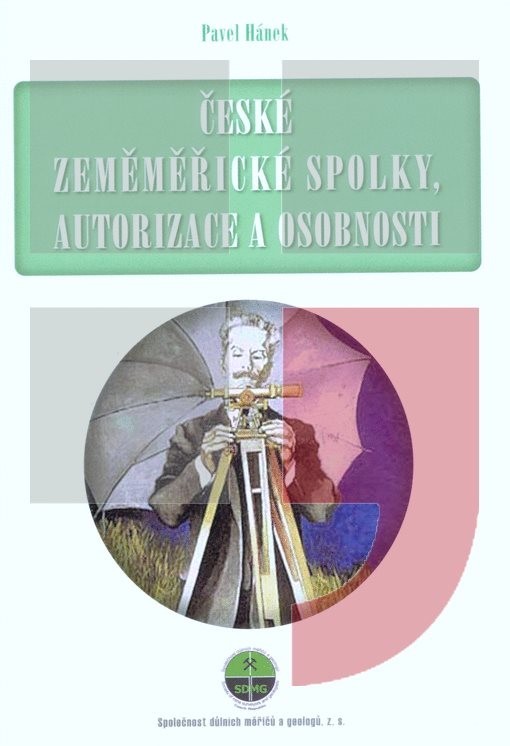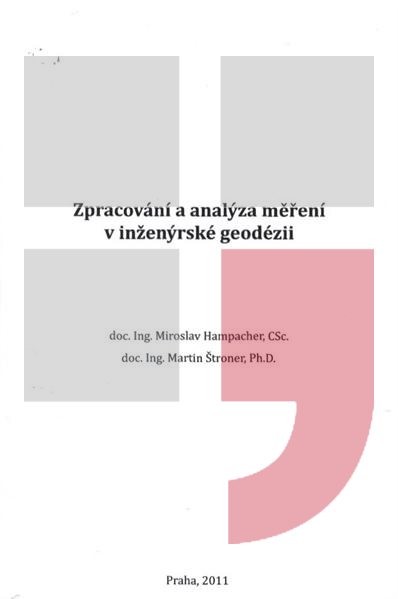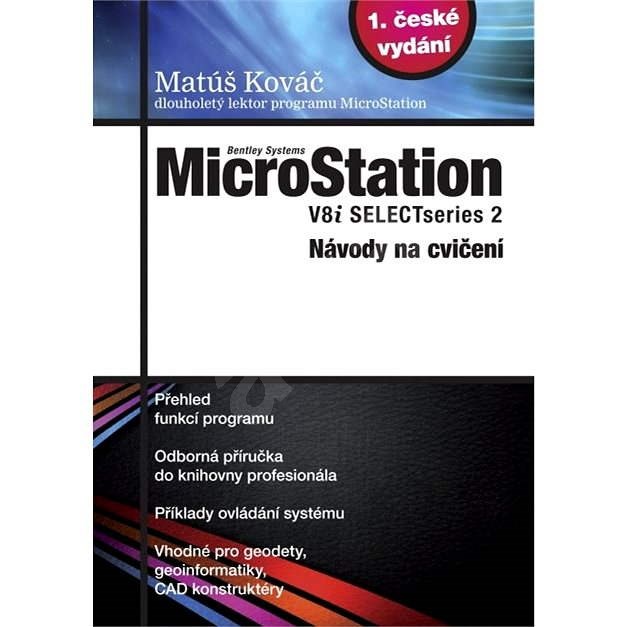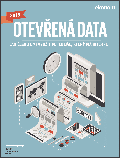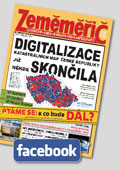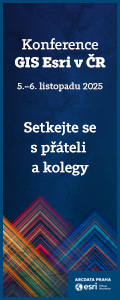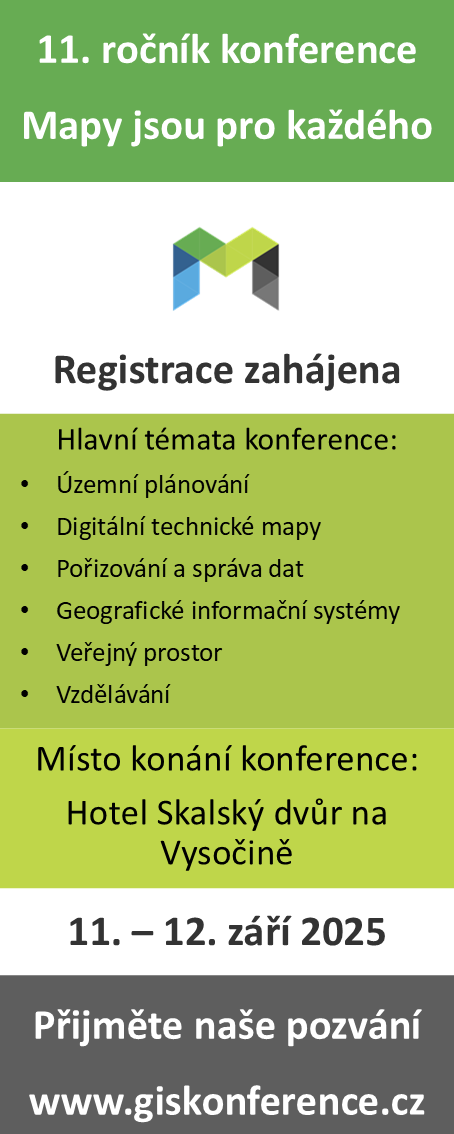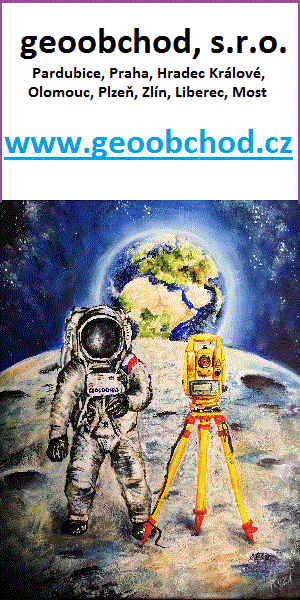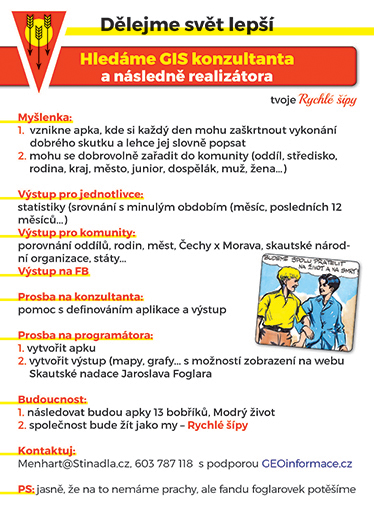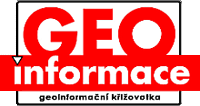zprávy
zdroje zpráv:Live from Krakow
14.9.2015 14:50 ESA Observing the Earth
Will CarbonSat or FLEX be ESA’s next Earth Explorer mission? Follow discussions at the User Consultation Meeting on 15–16 September
Odborný rada - povolování vkladů
14.9.2015 14:22 ČÚZK - volná místa /Urady/Katastralni-urady/Katastralni-urady/Katastralni-urad-pro-Liberecky-kraj/Uredni-deska/Oznameni-a-jina-uredni-sdeleni/Volna-mista/Odborny-rada-povolovani-vkladuOdborný rada - povolování vkladů
14.9.2015 14:22 ČÚZK /Urady/Katastralni-urady/Katastralni-urady/Katastralni-urad-pro-Liberecky-kraj/Uredni-deska/Oznameni-a-jina-uredni-sdeleni/Volna-mista/Odborny-rada-povolovani-vkladuOdborný rada - povolování vkladů
14.9.2015 14:22 ČÚZK - předpisy a opatření /Urady/Katastralni-urady/Katastralni-urady/Katastralni-urad-pro-Liberecky-kraj/Uredni-deska/Oznameni-a-jina-uredni-sdeleni/Volna-mista/Odborny-rada-povolovani-vkladuGISleaks, Aneb víme jaký bude program na Geomatice v projektech.
14.9.2015 13:01 GISportal.cz Tradiční konference Geomatika v projektech se blíží a nám se podařilo získat program konference dříve, než bude oficiálně zveřejněn. Na co se tedy můžete těšit? Aneta Rapaz OTN data hubs: stimulating innovation by improving access to open geographic ...Oznámení o vyhlášení výběrového řízení na služební místo odborný referent - zápisy v řízení V a Z, ř
14.9.2015 12:34 ČÚZK - předpisy a opatření /Urady/Katastralni-urady/Katastralni-urady/Katastralni-urad-pro-Plzensky-kraj/Uredni-deska/Oznameni-a-jina-uredni-sdeleni/Volna-mista/Oznameni-o-vyhlaseni-vyberoveho-rizeni-na-sluz-(1)Oznámení o vyhlášení výběrového řízení na služební místo odborný referent - zápisy v řízení V a Z, ř
14.9.2015 12:34 ČÚZK /Urady/Katastralni-urady/Katastralni-urady/Katastralni-urad-pro-Plzensky-kraj/Uredni-deska/Oznameni-a-jina-uredni-sdeleni/Volna-mista/Oznameni-o-vyhlaseni-vyberoveho-rizeni-na-sluz-(1)Oznámení o vyhlášení výběrového řízení na služební místo odborný referent - zápisy v řízení V a Z, ř
14.9.2015 12:34 ČÚZK - volná místa /Urady/Katastralni-urady/Katastralni-urady/Katastralni-urad-pro-Plzensky-kraj/Uredni-deska/Oznameni-a-jina-uredni-sdeleni/Volna-mista/Oznameni-o-vyhlaseni-vyberoveho-rizeni-na-sluz-(1)Vedoucí oddělení podpory informačních a komunikačních technologií
14.9.2015 12:05 ČÚZK - předpisy a opatření /Urady/Katastralni-urady/Katastralni-urady/Katastralni-urad-pro-Jihocesky-kraj/Volna-mista/Vedouci-oddeleni-podpory-informacnich-a-komunikacnVedoucí oddělení podpory informačních a komunikačních technologií
14.9.2015 12:05 ČÚZK /Urady/Katastralni-urady/Katastralni-urady/Katastralni-urad-pro-Jihocesky-kraj/Volna-mista/Vedouci-oddeleni-podpory-informacnich-a-komunikacnVedoucí oddělení podpory informačních a komunikačních technologií
14.9.2015 12:05 ČÚZK - volná místa /Urady/Katastralni-urady/Katastralni-urady/Katastralni-urad-pro-Jihocesky-kraj/Volna-mista/Vedouci-oddeleni-podpory-informacnich-a-komunikacnŘeditel kanceláře ředitele katastrálního úřadu
14.9.2015 12:03 ČÚZK /Urady/Katastralni-urady/Katastralni-urady/Katastralni-urad-pro-Jihocesky-kraj/Volna-mista/Reditel-kancelare-reditele-katastralniho-uraduŘeditel kanceláře ředitele katastrálního úřadu
14.9.2015 12:03 ČÚZK - předpisy a opatření /Urady/Katastralni-urady/Katastralni-urady/Katastralni-urad-pro-Jihocesky-kraj/Volna-mista/Reditel-kancelare-reditele-katastralniho-uraduŘeditel kanceláře ředitele katastrálního úřadu
14.9.2015 12:03 ČÚZK - volná místa /Urady/Katastralni-urady/Katastralni-urady/Katastralni-urad-pro-Jihocesky-kraj/Volna-mista/Reditel-kancelare-reditele-katastralniho-uraduŘeditel odboru obnovy katastrálního operátu
14.9.2015 12:00 ČÚZK /Urady/Katastralni-urady/Katastralni-urady/Katastralni-urad-pro-Jihocesky-kraj/Volna-mista/Reditel-odboru-obnovy-katastralniho-operatuŘeditel odboru obnovy katastrálního operátu
14.9.2015 12:00 ČÚZK - předpisy a opatření /Urady/Katastralni-urady/Katastralni-urady/Katastralni-urad-pro-Jihocesky-kraj/Volna-mista/Reditel-odboru-obnovy-katastralniho-operatuŘeditel odboru obnovy katastrálního operátu
14.9.2015 12:00 ČÚZK - volná místa /Urady/Katastralni-urady/Katastralni-urady/Katastralni-urad-pro-Jihocesky-kraj/Volna-mista/Reditel-odboru-obnovy-katastralniho-operatuObchodní konference Geosense 2015 ve znamení inovací
14.9.2015 12:00 Cleerio Přes 70 posluchačů se zúčastnilo dvoudenní obchodní konference Geosense. V konferenčním sále v pražských Vysočanech se sešli hosté, obchodní partneři z celé republiky a všichni obchodní zástupci Geosense CZ a Geosense SK. Připravena byla spousta zajímavých prezentací a informacemi nabité semináře. Oba dny se nesly na velké vlně novinek. Vše, na čem vývojáři, zpracovatelé, a vůbec celý tým Geosense v poslední době ustavičně pracoval a vylepšoval, zde bylo poprvé veřejně představeno. Dnes můžeme se štěstím a hrdostí říct, že strávený čas na vyvíjení a testování našich služeb se skutečně vyplatil a nejnovější inovace v nabídce Geosense se setkaly s kladnými ohlasy. Díky neustálému sbírání informací a naslouchání klientům přicházíme se službami, které přesně odpovídají jejich potřebám. A o jaké novinky se jedná? O všech se brzy dozvíte v podrobnějších zprávách, které pro Vás chystáme v následujících dnech. Pro začátek můžeme prozradit, že máme zcela nový mapový informační systém, vlastní mobilní aplikaci, nebo licenci na podrobné mapování území dronem....Řízení automatických robotů z oběžné dráhy
14.9.2015 11:52 Český Kosmický PortálKosmonaut ESA Andreas Mogensen se stal zkušeným „vesmírným řidičem“ poté, co v první polovině září na dálku ovládal dvě vozidla na Zemi přímo z oběžné dráhy. Jako součást projektu Meteron dokonce řídil přímo z Mezinárodní kosmické stanici rover o velikosti osobního vozidla, s jehož pomocí opravil maketu lunární základny nacházející se v Nizozemí.
Řízení automatických robotů z oběžné dráhy
14.9.2015 11:52 Český Kosmický PortálKosmonaut ESA Andreas Mogensen se stal zkušeným „vesmírným řidičem“ poté, co v první polovině září na dálku ovládal dvě vozidla na Zemi přímo z oběžné dráhy. Jako součást projektu Meteron dokonce řídil přímo z Mezinárodní kosmické stanici rover o velikosti osobního vozidla, s jehož pomocí opravil maketu lunární základny nacházející se v Nizozemí.
Nemoforum_Program_IMPE-GISTR
14.9.2015 11:19 ČÚZK - předpisy a opatření /O-resortu/Nemoforum/Nemoforum-uvod/Nemoforum_Program_IMPE-GISTR20150914 - Novinky verze 1.7
14.9.2015 10:49 ČÚZK - předpisy a opatření /Uvod/Produkty-a-sluzby/RUIAN/RUIAN-novinky/20150914-Novinky-verze-1-720150914 - Novinky verze 1.7
14.9.2015 10:49 ČÚZK /Uvod/Produkty-a-sluzby/RUIAN/RUIAN-novinky/20150914-Novinky-verze-1-7European Space Expo Heads to Milan
14.9.2015 10:41 European GNSS AgencyEurope’s travelling space show sets up at EXPO 2015 to show how space technology improves everyday life.
Milan is set to host the European Space Expo from September 18 through October 4, in conjunction with the ongoing World EXPO 2015. The traveling exhibition aims to illustrate how space and space activities have a direct impact on the daily lives of European citizens.
EXPO 2015 revolves around the theme “Feeding the Planet, Energy for Life” – a topic at the forefront of GSA applications. Today, more than 30,000 applications are based on space technologies. These apps include everything from maps to protecting the environment, optimizing agriculture, and more. GSA aims to create sustainable, resource-efficient solutions from space applications, particularly in the areas of energy and agriculture, where they will have a large impact on European’s daily lives.
First-hand Demonstrations
Throughout the duration of the exhibition, visitors will be able to watch concrete examples of space technologies such as Galileo and EGNOS: entertaining, interactive displays and hands-on project demos, as well as presentations, illustrate the contributions that space technologies make to “feeding the planet” and providing “energy for life”.
For example, the E-Track project, reveals the behaviour of wildlife and farm animals in order to assist in conservation work in natural parks and monitoring on farms.
G-Motit is using EGNOS and Galileo to improve mobility in urban environments and is showcasing its E-GNSS based electric scooter sharing service to Milan.
The MISTRALE unmanned areal vehicle (UAV) hanging inside the dome explains how to monitor the soil moisture by using the satellite signal. And visitors can learn about mapping areas with difficult access at the mapKITE demo. At the CNH/VanHolland demo, a playful demonstration with toy-tractors illustrate how high-tech tractors use EGNOs and Galileo to optimize agriculture outputs.
The Details
The European Space Expo, organized by the European Space DG Growth, the European GNSS Agency, and the European Space Agency, will be held at the Indro Montanelli Public Gardens. The show comes to Milan in partnership with the City of Milan, EXPO 2015, the Italian Space Agency, the Italian Air Force and Thales Alenia Space.
A ceremony will be held on September 18 at 10:30 AM to mark the opening of the exhibit, and organizers are excited to announce the attendance of ESA astronaut Paolo Nespoli.
The exhibit provides information in several languages, with a focus on EU flagship programs Galileo, EGNOS and Copernicus. Through these programs, European citizens benefit from numerous services and applications, not only enhancing daily life, but also creating opportunities on world markets and contributing to job creation and economic growth.
Media note: This feature can be republished without charge provided the European GNSS Agency (GSA) is acknowledged as the source at the top or the bottom of the story. You must request permission before you use any of the photographs on the site. If you republish, we would be grateful if you could link back to the GSA website (http://www.gsa.europa.eu).

European Space Expo Heads to Milan
14.9.2015 10:41 European GNSS AgencyEurope’s travelling space show sets up at EXPO 2015 to show how space technology affects everyday life.
Milan is set to host the European Space Expo from September 18 through October 4, in conjunction with the ongoing World EXPO 2015. The travelling exhibition aims to illustrate how space and space activities have a direct impact on the daily lives of European citizens.
EXPO 2015 revolves around the theme “Feeding the Planet, Energy for Life” – a topic at the forefront of GSA applications. Today, more than 30,000 applications are based on space technologies. These apps include everything from maps to protecting the environment, optimizing agriculture, and more. GSA aims to create sustainable, resource-efficient solutions from space applications, particularly in the areas of energy and agriculture, where they will have a large impact on European’s daily lives.
First-hand Demonstrations
Throughout the duration of the exhibit, visitors will be able to watch presentations and interact with the wide range of space technologies such as Galileo and EGNOS. Through entertaining, interactive displays and hands-on project demos, visitors will be exposed to the various contributions space makes to “feeding the planet” and providing “energy for life”.
For example, at the CNH/VanHolland demo, visitors can see how a tractor uses EGNOs and Galileo to optimize agriculture outputs, illustrated with toy tractors and an educational video make the exhibit fun for all participants.
G-Motit is using EGNOS and Galileo to improve mobility in urban environments and is showcasing its E-GNSS based electric scooter sharing service to Milan. Also on display is the E-Track project, which reveals the behaviour of wildlife and farm animals in order to assist in conservation work in natural parks and monitoring on farms. And visitors can learn about mapping areas with difficult access at the mapKITE demo, along with seeing a static drone demo at MISTRALE.
The Details
The European Space Expo, organized by the European Space DG Growth, the European GNSS Agency, and the European Space Agency, will be held at the Indro Montanelli Public Gardens. The show comes to Milan in partnership with the City of Milan, EXPO 2015, the Italian Space Agency, the Italian Air Force and Thales Alenia Space.
A ceremony will be held on September 18 at 10:30 AM to mark the opening of the exhibit, and organizers are excited to announce the attendance of ESA astronaut Paolo Nespoli.
The exhibit provides information in several languages, with a focus on EU flagship programs Galileo, EGNOS and Copernicus. Through these programs, European citizens benefit from numerous services and applications, not only enhancing daily life, but also creating opportunities on world markets and contributing to job creation and economic growth.
Media note: This feature can be republished without charge provided the European GNSS Agency (GSA) is acknowledged as the source at the top or the bottom of the story. You must request permission before you use any of the photographs on the site. If you republish, we would be grateful if you could link back to the GSA website (http://www.gsa.europa.eu).

European Space Expo Heads to Milan
14.9.2015 10:41 European GNSS AgencyEurope’s travelling space show sets up at EXPO 2015 to show how space technology improves everyday life.
Milan is set to host the European Space Expo from September 18 through October 4, in conjunction with the ongoing World EXPO 2015. The traveling exhibition aims to illustrate how space and space activities have a direct impact on the daily lives of European citizens.
EXPO 2015 revolves around the theme “Feeding the Planet, Energy for Life” – a topic at the forefront of GSA applications. Today, more than 30,000 applications are based on space technologies. These apps include everything from maps to protecting the environment, optimizing agriculture, and more. GSA aims to create sustainable, resource-efficient solutions from space applications, particularly in the areas of energy and agriculture, where they will have a large impact on European’s daily lives.
First-hand Demonstrations
Throughout the duration of the exhibition, visitors will be able to watch concrete examples of space technologies such as Galileo and EGNOS: entertaining, interactive displays and hands-on project demos, as well as presentations, illustrate the contributions that space technologies make to “feeding the planet” and providing “energy for life”.
For example, the E-Track project, reveals the behaviour of wildlife and farm animals in order to assist in conservation work in natural parks and monitoring on farms.
G-Motit is using EGNOS and Galileo to improve mobility in urban environments and is showcasing its E-GNSS based electric scooter sharing service to Milan.
The MISTRALE unmanned areal vehicle (UAV) hanging inside the dome explains how to monitor the soil moisture by using the satellite signal. And visitors can learn about mapping areas with difficult access at the mapKITE demo.. At the CNH/VanHolland demo, a playful demonstration with toy-tractors illustrate how high-tech tractors use EGNOs and Galileo to optimize agriculture outputs.
The Details
The European Space Expo, organized by the European Space DG Growth, the European GNSS Agency, and the European Space Agency, will be held at the Indro Montanelli Public Gardens. The show comes to Milan in partnership with the City of Milan, EXPO 2015, the Italian Space Agency, the Italian Air Force and Thales Alenia Space.
A ceremony will be held on September 18 at 10:30 AM to mark the opening of the exhibit, and organizers are excited to announce the attendance of ESA astronaut Paolo Nespoli.
The exhibit provides information in several languages, with a focus on EU flagship programs Galileo, EGNOS and Copernicus. Through these programs, European citizens benefit from numerous services and applications, not only enhancing daily life, but also creating opportunities on world markets and contributing to job creation and economic growth.
Media note: This feature can be republished without charge provided the European GNSS Agency (GSA) is acknowledged as the source at the top or the bottom of the story. You must request permission before you use any of the photographs on the site. If you republish, we would be grateful if you could link back to the GSA website (http://www.gsa.europa.eu).

Ředitel Odboru geodetických základů
14.9.2015 9:07 Zeměměřický úřad /Urady/Zememericky-urad/Uredni-deska/Oznameni-a-jina-uredni-sdeleni/Volna-mista/Reditel-Odboru-geodetickych-zakladuŘeditel Odboru geodetických základů
14.9.2015 9:07 ČÚZK - volná místa /Urady/Zememericky-urad/Uredni-deska/Oznameni-a-jina-uredni-sdeleni/Volna-mista/Reditel-Odboru-geodetickych-zakladuŘeditel Odboru geodetických základů
14.9.2015 9:07 ČÚZK /Urady/Zememericky-urad/Uredni-deska/Oznameni-a-jina-uredni-sdeleni/Volna-mista/Reditel-Odboru-geodetickych-zakladuŘeditel Odboru geodetických základů
14.9.2015 9:07 ČÚZK - předpisy a opatření /Urady/Zememericky-urad/Uredni-deska/Oznameni-a-jina-uredni-sdeleni/Volna-mista/Reditel-Odboru-geodetickych-zakladuŘeditel Odboru geodetických základů
14.9.2015 9:07 Zeměměřický úřad /Urady/Zememericky-urad/Volna-mista/Reditel-Odboru-geodetickych-zakladuŘeditel Odboru geodetických základů
14.9.2015 9:07 ČÚZK /Urady/Zememericky-urad/Volna-mista/Reditel-Odboru-geodetickych-zakladuŘeditel Odboru geodetických základů
14.9.2015 9:07 ČÚZK - volná místa /Urady/Zememericky-urad/Volna-mista/Reditel-Odboru-geodetickych-zakladuŘeditel Odboru správy a rozvoje informačního systému zeměměřictví
14.9.2015 9:07 ČÚZK /Urady/Zememericky-urad/Uredni-deska/Oznameni-a-jina-uredni-sdeleni/Volna-mista/Reditel-Odboru-spravy-a-rozvoje-informacniho-systeŘeditel Odboru správy a rozvoje informačního systému zeměměřictví
14.9.2015 9:07 Zeměměřický úřad /Urady/Zememericky-urad/Uredni-deska/Oznameni-a-jina-uredni-sdeleni/Volna-mista/Reditel-Odboru-spravy-a-rozvoje-informacniho-systeŘeditel Odboru správy a rozvoje informačního systému zeměměřictví
14.9.2015 9:07 ČÚZK - předpisy a opatření /Urady/Zememericky-urad/Volna-mista/Reditel-Odboru-spravy-a-rozvoje-informacniho-systeŘeditel Odboru správy a rozvoje informačního systému zeměměřictví
14.9.2015 9:07 ČÚZK - předpisy a opatření /Urady/Zememericky-urad/Uredni-deska/Oznameni-a-jina-uredni-sdeleni/Volna-mista/Reditel-Odboru-spravy-a-rozvoje-informacniho-systeŘeditel Odboru správy a rozvoje informačního systému zeměměřictví
14.9.2015 9:07 Zeměměřický úřad /Urady/Zememericky-urad/Volna-mista/Reditel-Odboru-spravy-a-rozvoje-informacniho-systeŘeditel Odboru správy a rozvoje informačního systému zeměměřictví
14.9.2015 9:07 ČÚZK /Urady/Zememericky-urad/Volna-mista/Reditel-Odboru-spravy-a-rozvoje-informacniho-systeŘeditel Odboru správy a rozvoje informačního systému zeměměřictví
14.9.2015 9:07 ČÚZK - volná místa /Urady/Zememericky-urad/Uredni-deska/Oznameni-a-jina-uredni-sdeleni/Volna-mista/Reditel-Odboru-spravy-a-rozvoje-informacniho-systeŘeditel Odboru správy a rozvoje informačního systému zeměměřictví
14.9.2015 9:07 ČÚZK - volná místa /Urady/Zememericky-urad/Volna-mista/Reditel-Odboru-spravy-a-rozvoje-informacniho-systeOznámení o vyhlášení výběrového řízení na služební místo vedoucího služebního úřadu - ředitele Katas
14.9.2015 8:50 ČÚZK - předpisy a opatření /Urady/Katastralni-urady/Katastralni-urady/Katastralni-urad-pro-Plzensky-kraj/Uredni-deska/Oznameni-a-jina-uredni-sdeleni/Volna-mista/Oznameni-o-vyhlaseni-vyberoveho-rizeni-na-sluzebniOznámení o vyhlášení výběrového řízení na služební místo vedoucího služebního úřadu - ředitele Katas
14.9.2015 8:50 ČÚZK /Urady/Katastralni-urady/Katastralni-urady/Katastralni-urad-pro-Plzensky-kraj/Uredni-deska/Oznameni-a-jina-uredni-sdeleni/Volna-mista/Oznameni-o-vyhlaseni-vyberoveho-rizeni-na-sluzebniOznámení o vyhlášení výběrového řízení na služební místo vedoucího služebního úřadu - ředitele Katas
14.9.2015 8:50 ČÚZK - volná místa /Urady/Katastralni-urady/Katastralni-urady/Katastralni-urad-pro-Plzensky-kraj/Uredni-deska/Oznameni-a-jina-uredni-sdeleni/Volna-mista/Oznameni-o-vyhlaseni-vyberoveho-rizeni-na-sluzebniNatáčeli jsme Národní kulturní památku Dolní Vítkovice
14.9.2015 8:10 UpVision Natáčeli jsme Národní kulturní památku - vysoké pece v Dolních Vítkovicích.Více fotek zde:
https://plus.google.com/+UpvisionCz1/posts/51stpGT5GUW
Na výstavu „My Planet from Space“ dorazil významný návštěvník
11.9.2015 11:50 Český Kosmický PortálNa výstavu „My Planet from Space: Fragility and Beauty“ (Má planeta z vesmíru, křehká a krásná) v New Yorku se uzavřela v úterý 8. září ceremoniálem, na který zavítal i generální tajemník OSN Pan Ki-mun.
Na výstavu „My Planet from Space“ dorazil významný návštěvník
11.9.2015 11:50 Český Kosmický PortálNa výstavu „My Planet from Space: Fragility and Beauty“ (Má planeta z vesmíru, křehká a krásná) v New Yorku se uzavřela v úterý 8. září ceremoniálem, na který zavítal i generální tajemník OSN Pan Ki-mun.
Platební karty
11.9.2015 8:07 ČÚZK - předpisy a opatření Vážení klienti,od 24.8.2015 Katastrální pracoviště Ostrava a Katastrální pracoviště Opava, Katastrálního úřad pro Moravskoslezský kraj, přijímají v rámci resortního pilotního projektu platební karty pro úhradu správního poplatku za vklad do katastru nemovitostí. V souladu se zákonem č. 284/2009 Sb., o platebním styku, je při platbě platební kartou účtován transakční poplatek ve výši 15,- Kč za každý vklad.
Gefos v žebříčku TOP 100 ICT společností
11.9.2015 7:00 Česká asociace pro geoinformace V prestižním žebříčku TOP 100 ICT společností, který mapuje nejúspěšnější firmy v oblasti informačních a komunikačních technologií na českém trhu, se na 72. místě objevila společnost GEFOS a.s, která je mimo jiné kolektivním členem České asociace pro geoinfromace. Gratulujeme!Žebříček každoročně sestavuje redakce časopisu CIO Business
21. setkání uživatelů GEPRO a ATLAS 2015 se blíží
11.9.2015 7:00 Česká asociace pro geoinformace Společnost GEPRO spol. s r.o., kolektivní člen CAGI, Vás srdečně zve k účasti na 21. ročníku tradiční konference Setkání uživatelů produktů a služeb společností GEPRO & ATLAS, která se uskuteční v hotelu Olšanka v Praze ve dnech 20. a 21. října 2015.Registrujte se prostřednictvím online formuláře do 4. října za zvýhodněné vložné!
Více informací o akci
Pozemská jízda kosmonauta Andrease Mogensena na ISS
10.9.2015 11:48 Český Kosmický PortálZasunout kulatý kolík do kulatého otvoru není zase až tak těžké, když člověk stojí hned u nich. Ovšem kosmonaut ESA Andreas Mogensen to zvládl ve chvíli, kdy se nacházel 400 kilometrů nad zemským povrchem na Mezinárodní kosmické stanici - zatímco ovládal robota s automatickou paží na Zemi.
Pozemská jízda kosmonauta Andrease Mogensena na ISS
10.9.2015 11:48 Český Kosmický PortálZasunout kulatý kolík do kulatého otvoru není zase až tak těžké, když člověk stojí hned u nich. Ovšem kosmonaut ESA Andreas Mogensen to zvládl ve chvíli, kdy se nacházel 400 kilometrů nad zemským povrchem na Mezinárodní kosmické stanici - zatímco ovládal robota s automatickou paží na Zemi.
Verze 12.40 našeho produktu PROLAND k dispozici
10.9.2015 11:19 GEPROZveřejnili jsme verzi 12.40 našeho produktu PROLAND.
Stahovat ji můžete z obvyklého umístění na našem download serveru.… >>
Programátor/ka odboru kartografie a polygrafie
10.9.2015 8:35 ČÚZK - předpisy a opatření /Urady/Zememericky-urad/Uredni-deska/Oznameni-a-jina-uredni-sdeleni/Volna-mista/Programator-ka-odboru-kartografie-a-polygrafieProgramátor/ka odboru kartografie a polygrafie
10.9.2015 8:35 ČÚZK - volná místa /Urady/Zememericky-urad/Uredni-deska/Oznameni-a-jina-uredni-sdeleni/Volna-mista/Programator-ka-odboru-kartografie-a-polygrafieProgramátor/ka odboru kartografie a polygrafie
10.9.2015 8:35 Zeměměřický úřad /Urady/Zememericky-urad/Uredni-deska/Oznameni-a-jina-uredni-sdeleni/Volna-mista/Programator-ka-odboru-kartografie-a-polygrafieProgramátor/ka odboru kartografie a polygrafie
10.9.2015 8:35 ČÚZK /Urady/Zememericky-urad/Uredni-deska/Oznameni-a-jina-uredni-sdeleni/Volna-mista/Programator-ka-odboru-kartografie-a-polygrafieT-Mapy hledají vývojáře PHP
9.9.2015 15:45 GeoBusiness Společnost T-MAPY hledá do svého týmu vývojáře. Pokud umíte přečíst následující kód, tak jste prošli prvním testem20150909-termíny zkoušek odborné způsobilosti
9.9.2015 13:12 ČÚZK /Aktuality-resort/2015/20150909-terminy-zkousek-odborne-zpusobilosti20150909-termíny zkoušek odborné způsobilosti
9.9.2015 13:12 ČÚZK - předpisy a opatření /Aktuality-resort/2015/20150909-terminy-zkousek-odborne-zpusobilostiAktuální šikmé letecké snímky měst ČR
9.9.2015 12:00 TopGis Šikmé letecké snímky jsou vhodným doplňkem ortofotomap, kterým jsme převážně v letošním roce nafotili už více jak 100 měst v ČR. Pořízené šikmé snímky určitě znáte z portálu Mapy.cz jako „ptačí pohled“. Poskytují uživatelům pohledy na města ze všech světových stran, na fasády budov i do blízkého okolí. Díky přesnému přímému georeferencování můžeme v našem SW GisManager umožnitOdborný rada - právník katastru nemovitostí na Katastrální pracoviště Praha-východ
9.9.2015 11:45 ČÚZK - předpisy a opatření /Urady/Katastralni-urady/Katastralni-urady/Katastralni-urad-pro-Stredocesky-kraj/Uredni-deska/Oznameni-a-jina-uredni-sdeleni/Volna-mista/Oznameni-o-vyhlaseni-vyberoveho-rizeni-na-sluz-(2)Odborný rada - právník katastru nemovitostí na Katastrální pracoviště Praha-východ
9.9.2015 11:45 ČÚZK - volná místa /Urady/Katastralni-urady/Katastralni-urady/Katastralni-urad-pro-Stredocesky-kraj/Uredni-deska/Oznameni-a-jina-uredni-sdeleni/Volna-mista/Oznameni-o-vyhlaseni-vyberoveho-rizeni-na-sluz-(2)Odborný rada - právník katastru nemovitostí na Katastrální pracoviště Praha-východ
9.9.2015 11:45 ČÚZK /Urady/Katastralni-urady/Katastralni-urady/Katastralni-urad-pro-Stredocesky-kraj/Uredni-deska/Oznameni-a-jina-uredni-sdeleni/Volna-mista/Oznameni-o-vyhlaseni-vyberoveho-rizeni-na-sluz-(2)Družice Galileo jsou na startovací rampě
9.9.2015 11:43 Český Kosmický PortálDevátá a desátá družice evropského navigačního systému Galileo už jsou na startovací rampě: zaujaly svoji pozici na nosiči Sojuz a jsou tak plně připraveny na páteční start.
Družice Galileo jsou na startovací rampě
9.9.2015 11:43 Český Kosmický PortálDevátá a desátá družice evropského navigačního systému Galileo už jsou na startovací rampě: zaujaly svoji pozici na nosiči Sojuz a jsou tak plně připraveny na páteční start.
20151013Inzerát-právník-KN-Phz
9.9.2015 10:50 ČÚZK - předpisy a opatření /Urady/Katastralni-urady/Katastralni-urady/Katastralni-urad-pro-Stredocesky-kraj/Katastralni-pracoviste/KP-Praha-zapad/O-uradu/Aktuality/20150909Inzerat-OR-KN-Phz20151013Inzerát-právník-KN-Phz
9.9.2015 10:50 ČÚZK /Urady/Katastralni-urady/Katastralni-urady/Katastralni-urad-pro-Stredocesky-kraj/Katastralni-pracoviste/KP-Praha-zapad/O-uradu/Aktuality/20150909Inzerat-OR-KN-PhzSlužební místo rada / odborný rada právního oddělení č. 1 na Katastrálním pracovišti Brno-město
9.9.2015 10:50 ČÚZK - volná místa /Urady/Katastralni-urady/Katastralni-urady/Katastralni-urad-pro-Jihomoravsky-kraj/Uredni-deska/Oznameni-a-jina-uredni-sdeleni/Volna-mista/Sluzebni-misto-rada-odborny-rada-pravniho-oddeleniSlužební místo rada / odborný rada právního oddělení č. 1 na Katastrálním pracovišti Brno-město
9.9.2015 10:50 ČÚZK - předpisy a opatření /Urady/Katastralni-urady/Katastralni-urady/Katastralni-urad-pro-Jihomoravsky-kraj/Uredni-deska/Oznameni-a-jina-uredni-sdeleni/Volna-mista/Sluzebni-misto-rada-odborny-rada-pravniho-oddeleniOznámení o vyhlášení výběrového řízení na služební místo rada / odborný rada právního oddělení č. 1
9.9.2015 10:50 ČÚZK - volná místa /Urady/Katastralni-urady/Katastralni-urady/Katastralni-urad-pro-Jihomoravsky-kraj/Uredni-deska/Oznameni-a-jina-uredni-sdeleni/Volna-mista/Sluzebni-misto-rada-odborny-rada-pravniho-oddeleniSlužební místo rada / odborný rada právního oddělení č. 1 na Katastrálním pracovišti Brno-město
9.9.2015 10:50 ČÚZK /Urady/Katastralni-urady/Katastralni-urady/Katastralni-urad-pro-Jihomoravsky-kraj/Uredni-deska/Oznameni-a-jina-uredni-sdeleni/Volna-mista/Sluzebni-misto-rada-odborny-rada-pravniho-oddeleniOznámení o vyhlášení výběrového řízení na služební místo rada / odborný rada právního oddělení č. 1
9.9.2015 10:50 ČÚZK /Urady/Katastralni-urady/Katastralni-urady/Katastralni-urad-pro-Jihomoravsky-kraj/Uredni-deska/Oznameni-a-jina-uredni-sdeleni/Volna-mista/Sluzebni-misto-rada-odborny-rada-pravniho-oddeleniOznámení o vyhlášení výběrového řízení na služební místo rada / odborný rada právního oddělení č. 1
9.9.2015 10:50 ČÚZK - předpisy a opatření /Urady/Katastralni-urady/Katastralni-urady/Katastralni-urad-pro-Jihomoravsky-kraj/Uredni-deska/Oznameni-a-jina-uredni-sdeleni/Volna-mista/Sluzebni-misto-rada-odborny-rada-pravniho-oddeleni20151013Inzerát-právník-KN-Phz
9.9.2015 10:48 ČÚZK /Urady/Katastralni-urady/Katastralni-urady/Katastralni-urad-pro-Stredocesky-kraj/O-uradu/Aktuality/20150909Inzerat-OR-KN-Phz20151013Inzerát-právník-KN-Phz
9.9.2015 10:48 ČÚZK - předpisy a opatření /Urady/Katastralni-urady/Katastralni-urady/Katastralni-urad-pro-Stredocesky-kraj/O-uradu/Aktuality/20150909Inzerat-OR-KN-PhzVrchní referent / rada personálního oddělení na Katastrálním úřadu pro Jihomoravský kraj
9.9.2015 10:04 ČÚZK - volná místa /Urady/Katastralni-urady/Katastralni-urady/Katastralni-urad-pro-Jihomoravsky-kraj/Uredni-deska/Oznameni-a-jina-uredni-sdeleni/Volna-mista/Vrchni-referent-rada-personalniho-oddeleni-na-KataVrchní referent / rada personálního oddělení na Katastrálním úřadu pro Jihomoravský kraj
9.9.2015 10:04 ČÚZK - předpisy a opatření /Urady/Katastralni-urady/Katastralni-urady/Katastralni-urad-pro-Jihomoravsky-kraj/Uredni-deska/Oznameni-a-jina-uredni-sdeleni/Volna-mista/Vrchni-referent-rada-personalniho-oddeleni-na-KataOznámení o vyhlášení výběrového řízení na služební místo vrchní referent / rada personálního oddělen
9.9.2015 10:04 ČÚZK - předpisy a opatření /Urady/Katastralni-urady/Katastralni-urady/Katastralni-urad-pro-Jihomoravsky-kraj/Uredni-deska/Oznameni-a-jina-uredni-sdeleni/Volna-mista/Vrchni-referent-rada-personalniho-oddeleni-na-KataOznámení o vyhlášení výběrového řízení na služební místo vrchní referent / rada personálního oddělen
9.9.2015 10:04 ČÚZK - volná místa /Urady/Katastralni-urady/Katastralni-urady/Katastralni-urad-pro-Jihomoravsky-kraj/Uredni-deska/Oznameni-a-jina-uredni-sdeleni/Volna-mista/Vrchni-referent-rada-personalniho-oddeleni-na-KataVrchní referent / rada personálního oddělení na Katastrálním úřadu pro Jihomoravský kraj
9.9.2015 10:04 ČÚZK /Urady/Katastralni-urady/Katastralni-urady/Katastralni-urad-pro-Jihomoravsky-kraj/Uredni-deska/Oznameni-a-jina-uredni-sdeleni/Volna-mista/Vrchni-referent-rada-personalniho-oddeleni-na-KataOznámení o vyhlášení výběrového řízení na služební místo vrchní referent / rada personálního oddělen
9.9.2015 10:04 ČÚZK /Urady/Katastralni-urady/Katastralni-urady/Katastralni-urad-pro-Jihomoravsky-kraj/Uredni-deska/Oznameni-a-jina-uredni-sdeleni/Volna-mista/Vrchni-referent-rada-personalniho-oddeleni-na-KataKartograf/ka odboru kartografie a polygrafie
9.9.2015 9:47 Zeměměřický úřad /Urady/Zememericky-urad/Uredni-deska/Oznameni-a-jina-uredni-sdeleni/Volna-mista/Kartograf-ka-odboru-kartografie-a-polygrafieKartograf/ka odboru kartografie a polygrafie
9.9.2015 9:47 ČÚZK - předpisy a opatření /Urady/Zememericky-urad/Uredni-deska/Oznameni-a-jina-uredni-sdeleni/Volna-mista/Kartograf-ka-odboru-kartografie-a-polygrafieKartograf/ka odboru kartografie a polygrafie
9.9.2015 9:47 ČÚZK /Urady/Zememericky-urad/Uredni-deska/Oznameni-a-jina-uredni-sdeleni/Volna-mista/Kartograf-ka-odboru-kartografie-a-polygrafieKartograf/ka odboru kartografie a polygrafie
9.9.2015 9:47 ČÚZK - volná místa /Urady/Zememericky-urad/Uredni-deska/Oznameni-a-jina-uredni-sdeleni/Volna-mista/Kartograf-ka-odboru-kartografie-a-polygrafieI Váš hlas rozhoduje: Sdělte Evropské komisi, jaké informace očekáváte od on-line plánovačů cest napříč Evropou
9.9.2015 8:55 Český Kosmický PortálInformace o situaci v dopravním provozu a informace o dopravním spojení a na ně navázaných službách mají za cíl poskytnout účastníkům silničního provozu a cestujícím veřejné osobní dopravy informace ke svobodné volbě pro individuální nebo hromadnou osobní dopravu, a to za současného poskytnutí informace o nejvhodnější časové poloze spojení, informace o přípojích, návazné dopravě z terminálu veřejné osobní dopravy a tarifních informací.
I Váš hlas rozhoduje: Sdělte Evropské komisi, jaké informace očekáváte od on-line plánovačů cest napříč Evropou
9.9.2015 8:55 Český Kosmický PortálInformace o situaci v dopravním provozu a informace o dopravním spojení a na ně navázaných službách mají za cíl poskytnout účastníkům silničního provozu a cestujícím veřejné osobní dopravy informace ke svobodné volbě pro individuální nebo hromadnou osobní dopravu, a to za současného poskytnutí informace o nejvhodnější časové poloze spojení, informace o přípojích, návazné dopravě z terminálu veřejné osobní dopravy a tarifních informací.
I Váš hlas rozhoduje: Sdělte Evropské komisi, jaké informace očekáváte od on-line plánovačů cest napříč Evropou
9.9.2015 8:55 Český Kosmický PortálInformace o situaci v dopravním provozu a informace o dopravním spojení a na ně navázaných službách mají za cíl poskytnout účastníkům silničního provozu a cestujícím veřejné osobní dopravy informace ke svobodné volbě pro individuální nebo hromadnou osobní dopravu, a to za současného poskytnutí informace o nejvhodnější časové poloze spojení, informace o přípojích, návazné dopravě z terminálu veřejné osobní dopravy a tarifních informací.
Danube Open (Geo) Data Hackathon
9.9.2015 7:00 Česká asociace pro geoinformace Ve dnech 15. - 17. října 2015 se v Bratislavě (Impact HUB) uskuteční Danube Open Geo Data Hackathon.Chcete ukázat, co všechno lze vytvořit pomocí otevřených geodat a příbuzných technologií? Jste producent otevřených dat a chtěl byste zjistit, co vše je možné z nich vytěžit?
Pokud ano, registrujte se do 25. září prostřednictvím online formuláře.
Více informací



